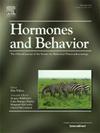Male, but not female, oxytocin receptor knockout prairie voles (Microtus ochrogaster) show impaired consolation behavior
IF 2.4
3区 医学
Q2 BEHAVIORAL SCIENCES
引用次数: 0
Abstract
Prosocial behaviors, including empathetic consoling toward others, contribute to maintaining social groups and social connections between individuals in many mammalian species, including monogamous prairie voles (Microtus ochrogaster). Prairie voles display consolation toward distressed partners by increasing allogrooming behavior toward the partner. A previous pharmacological study showed that oxytocin signaling contributes to consolation in male prairie voles, although possible sex differences in the regulation of consoling have not been explored. Here, we demonstrate that male, but not female, oxytocin receptor knockout (Oxtr −/−) prairie voles display disrupted consoling behavior toward distressed opposite sex partners who spend 24 h with their partners to form a pair bond. Notably, both male and female Oxtr −/− prairie voles showed normal partner preference following 24 h of cohabitation. Autoradiography for the vasopressin 1a receptor (AVPR1A) reveals no differences between genotypes in AVPR1A levels in the lateral septum, ventral pallidum, laterodorsal thalamic nucleus, and central amygdala, suggesting that the lack of OXTR does not lead to compensation via AVPR1A system at the receptor expression level in these selected brain regions. These findings demonstrate that OXTR modulates consolation in a sex-specific manner in prairie voles, while the lack of OXTR does not influence pair bonding.
雄性,而不是雌性,催产素受体敲除草原田鼠(Microtus ochrogaster)表现出受损的安慰行为
在许多哺乳动物物种中,亲社会行为,包括对他人的同情安慰,有助于维持社会群体和个体之间的社会联系,包括一夫一妻制草原田鼠(Microtus ochrogaster)。草原田鼠通过增加对伴侣的异种梳理行为来表达对痛苦伴侣的安慰。先前的一项药理学研究表明,催产素信号有助于雄性草原田鼠的安慰,尽管尚未探索在安慰调节方面可能存在的性别差异。在这里,我们证明了雄性,而不是雌性,催产素受体敲除(Oxtr−/−)草原田鼠对与伴侣共度24小时以形成伴侣关系的异性伴侣表现出中断的安慰行为。值得注意的是,雄性和雌性草原田鼠在同居24小时后都表现出正常的伴侣偏好。血管加压素1a受体(AVPR1A)的放射自显像显示,在侧隔、腹侧白质、丘脑外侧背核和中央杏仁核中,AVPR1A的水平在基因型之间没有差异,这表明OXTR的缺乏不会通过AVPR1A系统在这些被选中的大脑区域的受体表达水平上进行补偿。这些发现表明,在草原田鼠中,OXTR以性别特异性的方式调节安慰,而缺乏OXTR并不影响配对结合。
本文章由计算机程序翻译,如有差异,请以英文原文为准。
求助全文
约1分钟内获得全文
求助全文
来源期刊

Hormones and Behavior
医学-行为科学
CiteScore
6.70
自引率
8.60%
发文量
139
审稿时长
91 days
期刊介绍:
Hormones and Behavior publishes original research articles, reviews and special issues concerning hormone-brain-behavior relationships, broadly defined. The journal''s scope ranges from laboratory and field studies concerning neuroendocrine as well as endocrine mechanisms controlling the development or adult expression of behavior to studies concerning the environmental control and evolutionary significance of hormone-behavior relationships. The journal welcomes studies conducted on species ranging from invertebrates to mammals, including humans.
 求助内容:
求助内容: 应助结果提醒方式:
应助结果提醒方式:


